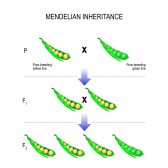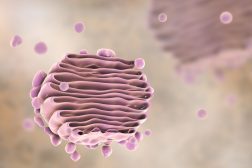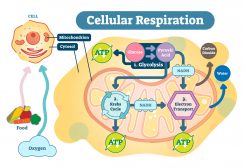Table of Contents
Definition
noun
plural: guanosine triphosphates
(biochemistry) An organic compound that is composed of guanosine (a guanine ring and a ribose sugar) and three phosphate groups, hence, the name; a nucleotide with a chemical formula of C10H16N5O14P3
Details
Overview
A nucleotide is an organic compound made up of three subunits: a nucleobase, a five-carbon sugar, and a phosphate group. The sugar component may either be ribose or deoxyribose. A nucleotide is, thus, a nucleoside with a phosphate group. Depending on the number of phosphate groups attached to the sugar moiety, a nucleotide may be called nucleoside monophosphate (if with only one phosphate group), nucleoside diphosphate (with two phosphate groups), or nucleoside triphosphate (when with three phosphate groups).
Depending on the pentose sugar component, a nucleoside may be a ribonucleoside or a deoxyribonucleoside. A ribonucleoside is a nucleoside with a ribose sugar component. Based on the nucleobase component, the ribonucleoside may be adenosine, guanosine, cytidine, uridine, or 5-methyluridine. A deoxyribonucleoside is a nucleoside with a deoxyribose sugar. Similarly, depending on the nucleobase component, a deoxyribonucleoside may be deoxyadenosine, deoxyguanosine, deoxycytidine, thymidine, or deoxyuridine. Also, depending on the nucleobase component, the nucleosides may be grouped into either the “double-ringed” purine or the “single-ringed” pyrimidine.
Structure
Guanosine triphosphate (GTP) (chemical formula: C10H16N5O14P3) is a nucleoside phosphate comprised of a ribonucleoside and three phosphate groups. It means it has a ribose as its sugar and three phosphate groups attached. Its structure is comprised of a purine base, particularly guanine that is bound at the 9′ nitrogen atom to the 1′ carbon atom of ribose sugar, and three phosphate groups attached to the 5′ carbon of the ribose. The removal of one or two phosphate groups yields guanosine monophosphate or guanosine diphosphate, respectively.
Common biological reactions
Common biological reactions
GTP is biosynthesized in different ways. One of the biosynthetic pathways is in the Krebs cycle where the enzyme succinyl-CoA synthetase catalyzes the conversion of succinyl-CoA to succinate and concurrently produces GTP as a byproduct. Another is by the action of the nucleoside-diphosphate kinase that regulates the concentrations of different nucleoside triphosphates.1
Biological functions
GTP contains chemical energy stored in its high-energy phosphate bonds. It releases energy when it is broken down (hydrolyzed) into GDP (guanosine diphosphate). The energy is used for many metabolic processes, such as gluconeogenesis and protein synthesis. Nevertheless, adenosine triphosphate (ATP), another nucleoside triphosphate, is considered as the universal energy currency for metabolism as it is used more readily in various metabolic processes including biosynthetic reactions, motility, and cell division. Even so, GTP may be converted into ATP via the enzyme nucleoside-diphosphate kinase.
GTP also serves as a monomeric unit of RNA. Furthermore, it plays a role in signal transduction involving G-proteins as GTP can be converted into GDP through the action of the enzyme GTPase. GTP, similar to ATP, has a crucial role in microtubule formation.
Supplementary
Abbreviation(s)
- GTP
Chemical formula
IUPAC
- ((2R,3S,4R,5R)-5-(2-amino-6-oxo-1,6-dihydro-9H-purin-9-yl)-3,4-dihydroxytetrahydrofuran-2-yl)methyl tetrahydrogen triphosphate
Synonyms
Further reading
See also
- nucleotide
- DNA
- RNA
- guanosine
- deoxyguanosine triphosphate (dGTP)
- guanosine monophosphate (GMP)
- guanosine diphosphate (GDP)
Reference
- Berg, J. M., Tymoczko, J. L., & Stryer, L. (2002). Biochemistry (5th ed.). WH Freeman and Company. p. 476
© Biology Online. Content provided and moderated by Biology Online Editors







